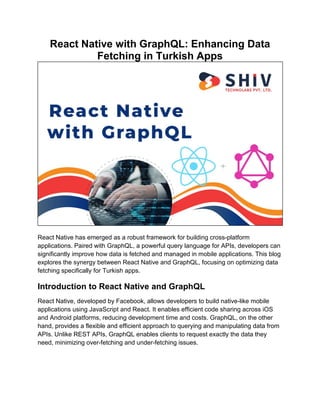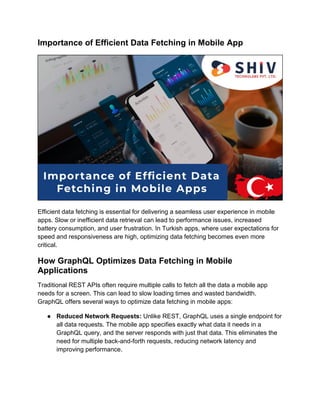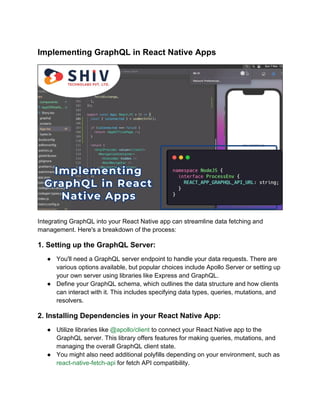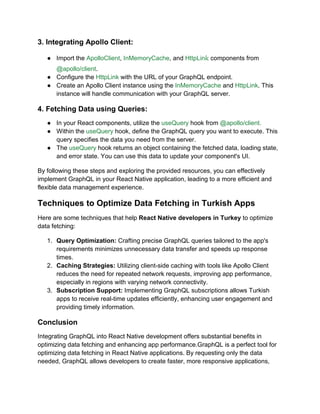Boosting Data Fetching in Turkish Apps with React Native and GraphQL
- 1. React Native with GraphQL: Enhancing Data Fetching in Turkish Apps React Native has emerged as a robust framework for building cross-platform applications. Paired with GraphQL, a powerful query language for APIs, developers can significantly improve how data is fetched and managed in mobile applications. This blog explores the synergy between React Native and GraphQL, focusing on optimizing data fetching specifically for Turkish apps. Introduction to React Native and GraphQL React Native, developed by Facebook, allows developers to build native-like mobile applications using JavaScript and React. It enables efficient code sharing across iOS and Android platforms, reducing development time and costs. GraphQL, on the other hand, provides a flexible and efficient approach to querying and manipulating data from APIs. Unlike REST APIs, GraphQL enables clients to request exactly the data they need, minimizing over-fetching and under-fetching issues.
- 2. Importance of Efficient Data Fetching in Mobile App Efficient data fetching is essential for delivering a seamless user experience in mobile apps. Slow or inefficient data retrieval can lead to performance issues, increased battery consumption, and user frustration. In Turkish apps, where user expectations for speed and responsiveness are high, optimizing data fetching becomes even more critical. How GraphQL Optimizes Data Fetching in Mobile Applications Traditional REST APIs often require multiple calls to fetch all the data a mobile app needs for a screen. This can lead to slow loading times and wasted bandwidth. GraphQL offers several ways to optimize data fetching in mobile apps: ● Reduced Network Requests: Unlike REST, GraphQL uses a single endpoint for all data requests. The mobile app specifies exactly what data it needs in a GraphQL query, and the server responds with just that data. This eliminates the need for multiple back-and-forth requests, reducing network latency and improving performance.
- 3. ● Precise Data Fetching: GraphQL empowers developers to request only the specific data fields required for the UI. This avoids over-fetching unnecessary data that consumes bandwidth and clutters the app's memory. ● Flexible Data Structure: GraphQL allows requesting data across different resources and relationships in a single query. This eliminates the need for complex logic on the mobile app side to combine data from separate REST endpoints. ● Improved Offline Capabilities: Since GraphQL queries precisely define the data needed, mobile apps can more effectively cache relevant data for offline use. This provides a smoother user experience even when encountering connectivity issues. Overall, GraphQL's focus on requesting only the essential data and its flexible querying capabilities make it a powerful tool for optimizing data fetching in mobile applications, leading to faster load times, improved performance, and a more responsive user experience.
- 4. Implementing GraphQL in React Native Apps Integrating GraphQL into your React Native app can streamline data fetching and management. Here's a breakdown of the process: 1. Setting up the GraphQL Server: ● You'll need a GraphQL server endpoint to handle your data requests. There are various options available, but popular choices include Apollo Server or setting up your own server using libraries like Express and GraphQL. ● Define your GraphQL schema, which outlines the data structure and how clients can interact with it. This includes specifying data types, queries, mutations, and resolvers. 2. Installing Dependencies in your React Native App: ● Utilize libraries like @apollo/client to connect your React Native app to the GraphQL server. This library offers features for making queries, mutations, and managing the overall GraphQL client state. ● You might also need additional polyfills depending on your environment, such as react-native-fetch-api for fetch API compatibility.
- 5. 3. Integrating Apollo Client: ● Import the ApolloClient, InMemoryCache, and HttpLink components from @apollo/client. ● Configure the HttpLink with the URL of your GraphQL endpoint. ● Create an Apollo Client instance using the InMemoryCache and HttpLink. This instance will handle communication with your GraphQL server. 4. Fetching Data using Queries: ● In your React components, utilize the useQuery hook from @apollo/client. ● Within the useQuery hook, define the GraphQL query you want to execute. This query specifies the data you need from the server. ● The useQuery hook returns an object containing the fetched data, loading state, and error state. You can use this data to update your component's UI. By following these steps and exploring the provided resources, you can effectively implement GraphQL in your React Native application, leading to a more efficient and flexible data management experience. Techniques to Optimize Data Fetching in Turkish Apps Here are some techniques that help React Native developers in Turkey to optimize data fetching: 1. Query Optimization: Crafting precise GraphQL queries tailored to the app's requirements minimizes unnecessary data transfer and speeds up response times. 2. Caching Strategies: Utilizing client-side caching with tools like Apollo Client reduces the need for repeated network requests, improving app performance, especially in regions with varying network connectivity. 3. Subscription Support: Implementing GraphQL subscriptions allows Turkish apps to receive real-time updates efficiently, enhancing user engagement and providing timely information. Conclusion Integrating GraphQL into React Native development offers substantial benefits in optimizing data fetching and enhancing app performance.GraphQL is a perfect tool for optimizing data fetching in React Native applications. By requesting only the data needed, GraphQL allows developers to create faster, more responsive applications,
- 6. reduce network traffic, preserve battery life, and overall provide a better experience for Turkish users. Turkish developers can leverage locale awareness, data pre-fetching, and Gzip compression to further enhance the data-fetching experience for their Turkish audience. By considering these techniques, React Native development company in Turkey can build efficient and user-friendly applications that cater to the specific needs of the Turkish market.






